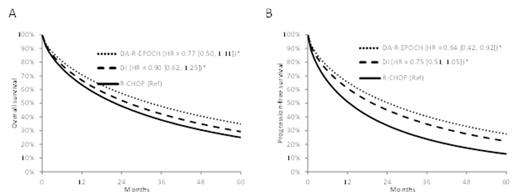Abstract
Introduction: Double-hit lymphoma (DHL), characterized by the presence of both c-Myc and BCL-2 rearrangements, is an aggressive B-cell non-Hodgkin's lymphoma (NHL) that is clearly associated with an inferior prognosis compared to standard risk DLBCL. DHL pts do poorly when treated with R-CHOP and typically cannot be salvaged once relapsed. Studies examining the treatment of DHL pts have been small and there is a lack of consensus in the lymphoma community as to whether DHL pts benefit from dose-escalated chemotherapy regimens in the front-line setting. To address this question, we generated pooled, meta-analytic estimates of the effectiveness of dose-escalated approaches vs. standard dose immunochemotherapy in prolonging overall survival (OS) and progression-free survival (PFS) in newly diagnosed DHL pts.
Methods: DHL was defined by the presence of c-Myc rearrangement (FISH) in combination with BCL2 rearrangement (FISH) in pts with DLBCL or transformed follicular lymphoma. Treatment regimens included dose intensive (DI; R-Hyper-CVAD, R-CODOX-M/IVAC), intermediate dose [Dose adjusted (DA)-R-EPOCH], or standard dose (R-CHOP). PubMed, Embase, and abstracts at 3 specific congresses from 1/2009 to 6/2014 were searched using terms lymphoma with DHL, dual hit, dual translocation, double-hit, or myc and bcl2. Randomized controlled trials and observational studies evaluating treatment of DHL were eligible for inclusion. Studies of ≤ 10 DHL pts were excluded. Data were collected from study authors or extracted from publications as the proportions of pts surviving at specific follow-up times or individual event times. Data were synthesized to estimate the hazard ratios of higher-dose treatments relative to R-CHOP using a Weibull proportional hazards model within a Bayesian meta-analysis framework.
Results: The initial search yielded 996 hits and 57 congress abstracts. After independent review by three investigators, 11 studies examining 401 pts were included in the analysis. Pts were treated with either R-CHOP (n=180), DA-R-EPOCH (n=91), or DI regimen (n=130) in the front-line setting. There were no significant differences in baseline characteristics of pts between included studies or across treatment regimens (median age at diagnosis 60 years, median Ki-67 88%, 53% IPI ≥ 3). The estimated median (and 95% credible intervals [CrIs; the Bayesian analog to confidence intervals]) OS and PFS for the entire cohort were 27.8 (15.1-48.5) and 20.5 (10.9-36.0) months. No significant differences in OS (n=374) were observed among any of the treatments (estimated med OS: R-CHOP, DA-R-EPOCH and DI were 24.2, 37.5, and 29.5 months, respectively, Figure A). Estimated hazard ratios (HR) of OS were 0.77 (95% CrI: 0.50-1.11) for DA-R-EPOCH and 0.90 (95% CrI: 0.62-1.25) for DI relative to R-CHOP. The PFS (n=357) among pts receiving DA-R-EPOCH (HR 0.64, 95% CrI: 0.42-0.92) or DI (HR 0.75, 95% CrI: 0.51-1.05) was similar and DA-R-EPOCH demonstrated significant improvement over R-CHOP (estimated med PFS: R-CHOP, DA-R-EPOCH and DI of 13.9, 27.8, and 21.9, respectively, Figure B).
Conclusions: In the largest study and first meta-analysis of treatment outcomes in DHL pts, we have demonstrated that dose-escalated chemotherapy was associated with a significant increase in PFS (particularly DA-R-EPOCH) which did not translate into an OS advantage. This suggests DHL is a disease of chemotherapy resistance. One can consider the use of dose-escalated front-line therapies as they can lead to a PFS advantage and that consolidation strategies should be developed to reduce the likelihood of relapse. These results highlight (1) outcomes remain poor for DHL pts regardless of the intensity of R-chemotherapy induction (2) the need for routine screening for MYC and BCL2 by FISH in DLBCL pts with high-risk features and (3) the need for prospective induction and consolidation strategies that incorporate our growing understanding of the biological basis of DHL such as combinations of novel targeted therapies and/or upfront consolidation with CAR-T-cells.
Weibull meta-analysis estimates of OS (A) and PFS (B) with hazard ratios and 95% credible intervals; *in Bayesian analyses, statistically meaningful differences between treatments are not assessed by P-values, but by whether the CrI contains the value 1, indicating the probability of lower risk of event is <97.5%.
Weibull meta-analysis estimates of OS (A) and PFS (B) with hazard ratios and 95% credible intervals; *in Bayesian analyses, statistically meaningful differences between treatments are not assessed by P-values, but by whether the CrI contains the value 1, indicating the probability of lower risk of event is <97.5%.
Cohen:Pharmacyclics: Consultancy; Seattle Genetics: Consultancy; BMS: Research Funding; Janssen: Research Funding. Mato:Celgene: Honoraria, Research Funding.
Author notes
Asterisk with author names denotes non-ASH members.


This feature is available to Subscribers Only
Sign In or Create an Account Close Modal